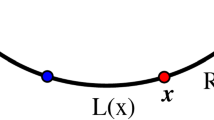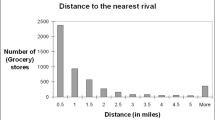Abstract
Traditional location theory analyzes the behavior of a monopolist selling a good (service) in a spatial market having identical customers distributed at uniform density. However, customers in highly urbanized societies rarely exhibit uniform (flat) densities. Consequently, location theory has lost some of its relevance for clarifying how firms should behave in densely populated spatial markets. This paper uses a downward-sloping function, centered on the point of sales, to represent the type of customer gradient that is now common in urban settings. Therefore, the location-specific demand density for a low-order retail good is determined by the interaction between a (single-good) linear pricing system and a linear customer gradient. The spatial monopolist must adjust its price to both exogenous factors when seeking to maximize profit in the market. Under a mill (f.o.b.) price system, a steeper customer density induces the monopolist to raise its price higher to maintain its profit.
Similar content being viewed by others
References
Beckmann MJ (1968) Location theory. Random House, New York
Beckmann MJ, Thisse J-F (1986) The location of production activities. In: Nijkamp P (ed) Handbook of regional and urban economics, vol 1. North-Holland, Amsterdam, pp 21–95
Berry BJL, Horton FE (eds) (1970) Geographic perspectives on urban systems. Prentice-Hall, Englewood Cliffs NJ
Capello R (2019) Space, growth and development: a historical perspective and recent advances. In: Capello R, Nijkamp P (eds) Handbook of regional growth and development theories (revised and extended 2nd edition). Edward Elgar, Cheltenham UK, pp 24–47
Eaton BC (1976) Free entry in one-dimensional markets: pure profits and multiple equilibria. Journal of Regional Science 16:21–33
Henderson JV (1985) Economic theory and the cities, 2nd edn. Academic Press, Orlando FL
Henderson JM, Quandt RE (1958) Microeconomic theory. McGraw-Hill, New York
Hoover EM (1948) The location of economic activity. McGraw-Hill, New York
Isard W (1956) Location and space-economy. MIT Press, Cambridge MA
Isard W, Liossatos P (1979) Spatial dynamics and optimal space-time development. North-Holland, Amsterdam
Lloyd P, Dicken P (1977) Location in space, 2nd edn. Harper and Row, New York
Lösch A (1954) In: Woglom W (ed) The economics of location. Yale University Press, New Haven
Mills ES (1972) Studies in the structure of the urban economy. Johns Hopkins University Press, Baltimore
Mulligan GF (2012) Stochastic shopping and consumer heterogeneity. Studies in Regional Science 42:93–107
Perrings W, Hannon B (2001) An introduction to spatial discounting. Journal of Regional Science 41:23–38
Shy O (1995) Industrial organization: theory and applications. MIT Press, Cambridge
Warntz W (1959) Toward a geography of price. University of Pennsylvania Press, Philadelphia
Acknowledgements
Parts of this paper were presented in a special session at the 55th Annual Meeting of the Japan Section, RSAI held in Sapporo, Japan, during October 6–8, 2018. The author would like to thank Peter Nijkamp and Kingsley Haynes for their comments in that session and one referee for pointing out a source of confusion in an earlier version of the paper. This research was not supported by any external funding.
Author information
Authors and Affiliations
Corresponding author
Additional information
Publisher's Note
Springer Nature remains neutral with regard to jurisdictional claims in published maps and institutional affiliations.
About this article
Cite this article
Mulligan, G.F. Effects of a customer gradient in a spatial monopoly. Asia-Pac J Reg Sci 5, 155–167 (2021). https://doi.org/10.1007/s41685-019-00142-7
Received:
Accepted:
Published:
Issue Date:
DOI: https://doi.org/10.1007/s41685-019-00142-7




